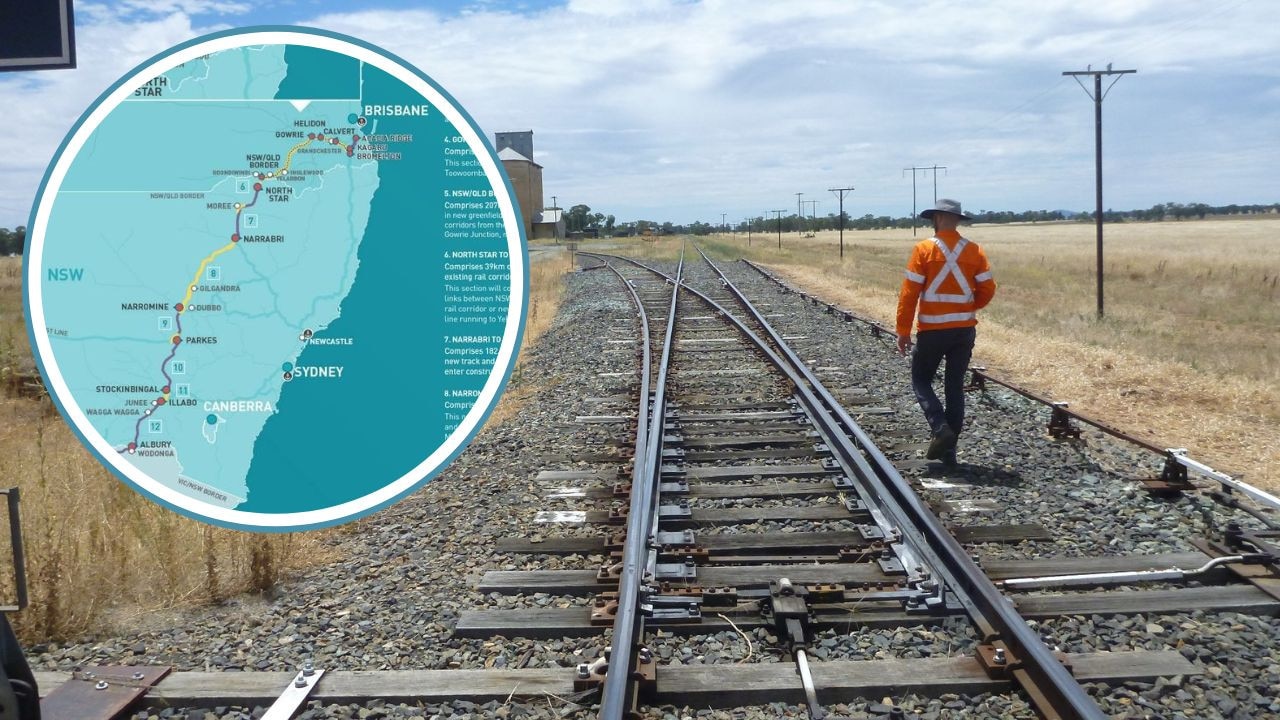The Inland Rail project between Melbourne and Brisbane has stalled with just 17 per cent complete, and insiders say it is unlikely it will ever reach the end of the line.
Political infighting, poor planning and governance, and increasing delays to environmental approvals have significantly reduced the scope of the transformative nation-building project, while simultaneously blowing out the cost from $9.3bn to $31.4bn.
There are no guarantees the line will even cross into Queensland, with the $14.6bn in confirmed funding now restricted to south of the border.
Environmental approvals, required before construction could begin in Queensland, are “years away”, a Senate committee was told last month. The Albanese government is increasingly reluctant to commit to the project’s end point or a timeline for when it could be finished.
When construction started in 2018, the train line was due to be completed by 2027 and was going to run 1600km, from Tottenham in Melbourne to Acacia Ridge in Brisbane.
Two disjointed sections, totalling about 300km, between Parkes, west of Sydney, and North Star, near the Queensland border, are effectively completed, but sit isolated from the rest of the upgraded line further south.
Further funding is locked in for a 650km stretch from Beveridge, 40km north of Melbourne, to Parkes, with an estimated completion date of 2027.
Rail advocates and industry sources in Queensland fear it will never make it into the state, casting doubt on the public-private partnerships intended to fund a significant portion of the Queensland section and spooking the investors planning interacting infrastructure.
Formally, following the 2023 review of the project by former government and business executive Kerry Schott, the government said it would eventually build the line from Beveridge to Kagaru, 70km from the Port of Brisbane.
But after the review, the signed public-private partnership contract to deliver the section from Gowrie, near Toowoomba, to Kagaru was terminated.
Inland Rail chief executive Nick Miller last month told a Senate committee the government was “committed” to that route.
But several people close to the project interviewed by The Australian doubted it would ever progress east of Toowoomba because of the high cost of tunnelling through the Great Dividing Range and fierce local opposition to trains passing through rural and residential areas closer to Brisbane.

Corporate fundraiser and policy advocate Everald Compton, often referred to as the “father” of the Inland Rail concept, said he did not think the rail line would make it further east than Toowoomba.
“It will never, ever get there,” Mr Compton told The Australian.
“If the Inland Rail is built from Melbourne to Goondiwindi and then direct to Toowoomba, that’s as far as it would go, and Toowoomba would become the major freight hub for southeast Queensland.”
An Inland Rail representative said the organisation was still working with state and local governments to gain approvals to design the Queensland leg of the track, but could not estimate a start or completion date.
“These activities include the completion of all regulatory approvals and land acquisition for the project corridor, along with surveys and on-site site investigations to help provide more certainty that Inland Rail can be built to an agreed budget and time frame,” the spokesman said.
The company said the cost of the project had blown out because of the prolonged approvals process, “rising inflation, increased cost of materials, continued supply-chain shortages and interruptions, a tight labour market that increased labour costs, as well as rising interest rates and borrowing costs”.
Much of the work from Beveridge to Parkes is to upgrade existing rail lines to accommodate faster speeds and double-stacked trains carrying two intermodal containers, as well as replacing or modifying bridges and other infrastructure. But the Queensland section involves building new dual-gauge tracks through a new and ever-changing greenfield corridor.
Even if funding was available, those sections are not even close to construction approval and await an environmental approval process that is expected to take several years.

Toowoomba Mayor Geoff McDonald and a cohort of the region’s business leaders, who last week met with federal Infrastructure and Transport Minister Catherine King to discuss the project, advocated for the line to at least make it to Gowrie on the city’s outskirts, where “substantial private investment” is in limbo.
“We are advised that government is confirming outstanding cost and environmental information, but progress after years and years of consideration must be the priority,” Toowoomba Surat Basin Enterprise chief executive April Cavanagh said.
“Getting Inland Rail to Queensland means more investment.
“On the ground we are ready to go – we have businesses lined up who are ready to invest and ramp up regional industry and employment. We just need the confidence and commitment from the federal government that this vital enabling infrastructure is full steam ahead for the Toowoomba region and Queensland.”
A spokeswoman for Ms King said the government’s new “staged approach” was necessary to allow it to make informed decisions.
“North of Narromine work is focusing on gaining required environmental approvals and securing the land needed for the project corridor, to provide sufficient certainty that the project can be completed to an agreed budget and time frame,” the spokeswoman said.
“In accordance with the government response to the Schott review, the Australian government agrees in principle that Inland Rail should extend at least to Ebenezer in Queensland, following the work north of Narromine outlined above and subject to completion and consideration of the Ebenezer intermodal terminal business case.”
There is also a push, backed by an ongoing $10m business case, to take the rail line from Toowoomba to Gladstone port, and another private business proposal, led by Mr Compton’s GreenLink company, to take the project from Goondiwindi, on the Queensland border, to Gladstone.
Source: The Australian



